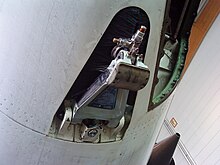Tailbumper

In aviation, a tailbumper (from English tail = "rear" and to bump = "bounce, collide") is a protective device at the rear of aircraft, which is intended to protect the aircraft from damage in the event of a tail strike during take-off or landing. With tailstrike the impact of the tail on is the point of rotation at too steep an angle (Engl. Angle of attack ), respectively.
Tailbumpers exist in different designs. The Concorde had a small, additional wheel attached to the tail of the aircraft. The Airbus family has a metal reinforcement in the critical area of the rear fuselage.
For the mandatory certification tests ( VMU test and TOP test ) of the Airbus A 380, in which tail strikes had to be intentionally caused, special hydraulic flight test tail bumpers were developed for the rear, which on the one hand the rear protected against damage and, on the other hand, were able to determine all parameters relevant to the load-bearing capacity of the aircraft tail, such as force, speed and time using opto-electronic and piezo-electronic sensors. Normal tailbumpers made of steel grinding plates or oak blocks were not possible because of the huge moving mass.
Tailbumpers, often J -shaped brackets made of tubular steel (bending if necessary) or wire (deflecting), are also found on gliders and helicopters .
literature
- Airbus relies on Enidine. Press release at Intec 2006, Bad Bellingen, July 26, 2006
- Warren E. Thompson: F3D Skyknight: A Match For The MiG. In: Combat Aircraft , December 2000
